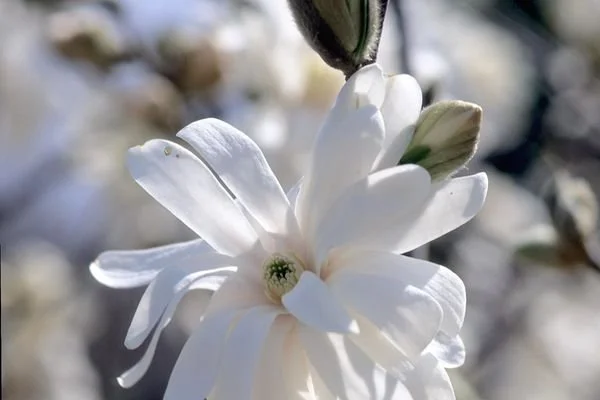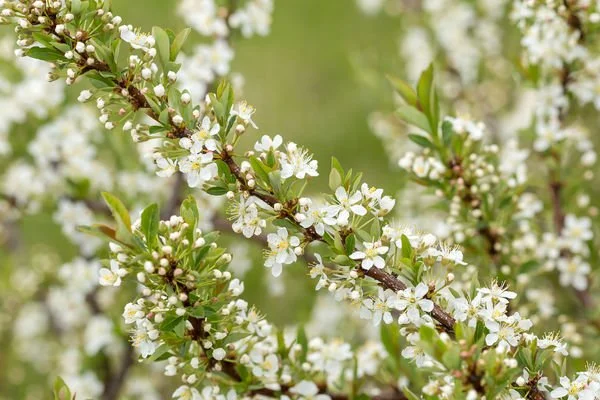The current season is well underway, and there's a palpable sense of excitement in the air. As blossoms start to unfurl, we're taking the opportunity to showcase a select few that are particularly noteworthy this month.
These botanical wonders, some of which have been absent for a time or were previously available only in limited quantities, each contribute their own unique charm to landscaping endeavors. Eager to discover the ideal addition for your envisioned outdoor oasis? Delve into the specifics provided below and prepare to elevate your outdoor space to new heights!
Royal Star Magnolia
Image source: Bailey Nurseries
Description:
This hardy Japanese magnolia remains among the most popular. In April its pink buds open to double white fragrant flowers of 25-30 petals, 3-4 inches in diameter. An upright and densely branched plant, it has dark green foliage that shifts to bronze in fall.
Species Specs
Height: 8-10’
Spread: 8-10’
Shape: Compact, Rounded
Exposure: Full Sun
Foliage: Deep Green
Zone: 4-8
Plant Care:
Grows easily in deep, nutrient-rich, well-drained, loamy soil, but adaptable. Shelter from harsh winter winds and late season cold snaps. Water deeply, regularly during first few growing seasons to establish extensive root system; once established, water regularly to maintain evenly moist soil. Feed in early spring before new growth emerges.
Lynwood Gold Forsythia
Image source: Bailey Nurseries
Description:
Deep golden yellow flowers of this forsythia cover the branches in April. A dense plant with an upright habit, it tolerates city conditions well. It may experience dieback of flower buds in zone 4, but performs well in both sun or light shade. Rarely to never fed on by Japanese beetles.
Species Specs
Height: 5-7’
Spread: 7’
Shape: Upright
Exposure: Full Sun to Part Shade
Foliage: Deep green
Zone: 4-8
Plant Care:
The Lynwood Gold Forsythia is an easy to grow shrub that is drought, deer, pollution, and salt tolerant. Water deeply 1 - 2 times per week when newly planted. Once established, watering is only needed in periods of severe drought. Fertilize once per year in spring to promote the brightest colored flowers.
Prune after blooming is over to control size and shape. It is important to prune right after flowers have bloomed because flowers form on old wood. You can cut back old growth as far back as 4 inches to the ground.
Jade Parade® Sand Cherry
Image source: Bailey Nurseries
Description:
We see this as a plant that may give landscapers a fresh perspective on mass planting groundcovers, and as an alternative to Gro-Low sumac. The foliage is an attractive glossy blueish-green, turning shades of yellow, orange, and red in the fall. Jade Parade® has a spreading habit, but rather than just creeping along the ground, the branches arch upwards. The bonus in spring is the small ½” white blooms that flower profusely along the stems and are followed by small black cherries in late summer. Very tolerant of full sun and dry conditions once established.
Species Specs
Height: 2-3’
Spread: 4-6’
Shape: Spreading
Exposure: Full Sun
Foliage: Green
Zone: 3-7
Plant Care:
Apply a moderate amount of water on a consistent schedule for the first season. After that, apply supplemental water during long periods of hot, dry weather.
Wait to prune until the flowers are done, as this selection blooms on old growth. Prune to shape at that time by reducing the length of wayward branches. To enjoy both flowers and fruit, renewal prune in spring to remove the oldest, fattest branches and let younger, more vigorous stems take their place.
Shadowland® Empress Wu Hosta
Image source: Monrovia Nurseries
Description:
The largest known hosta available! This massive plant forms a gigantic upright mound of huge, thick, dark green leaves topped with pale reddish violet flowers. It will make a fantastic statement in your shade garden.
Species Specs
Height: 3-4’
Spread: 5-6’
Shape: Upright mound
Exposure: Part Shade to Full Shade
Foliage: Dark Green
Zone: 3-9
Plant Care:
Performs well in average or fertile soil, average water needs. In spring, a light fertilizer can be applied around the emerging plant, but not touching it. Groom plants by removing yellow or dead leaves and cut flower spikes back as they finish blooming in summer. Leave foliage standing in fall to help protect the crown. If desired, a layer of mulch can be applied in a 2" layer very near the base.




